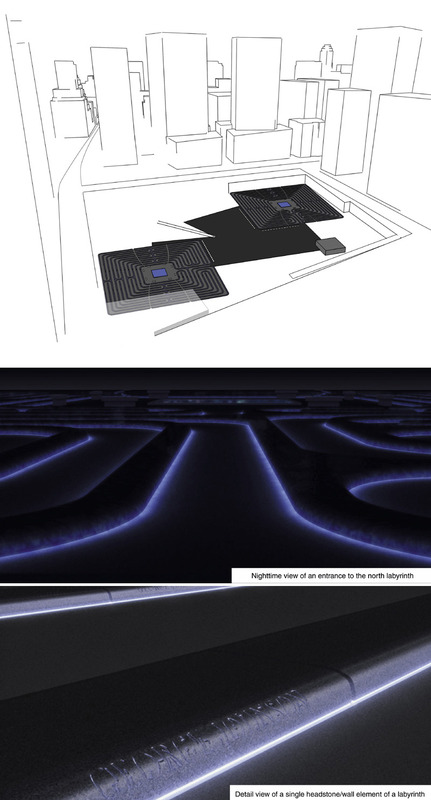WTC Memorial

I was approached in 2003 by my good friend, Virginia Barry, to help her realize her vision for a World Trade Center Memorial. After learning of the competition, she was drawn to labyrinths as a design concept. Peter Roesch and I helped her refine this idea and together we came up with this design. I am deeply grateful to Virginia for including me in this project. I am reprinting Virginia’s text that accompanied the poster we submitted to the committee.
The events that culminated in the fall of the World Trade Center Towers inflicted individual and collective trauma. Our ways of seeing ourselves and our nation and our world were altered irrevocably. To provide a site for and a guide to healing, we are proposing to construct a labyrinth.
A labyrinth is traditionally a unicursal path. There is only one entrance and one path. People who traverse the labyrinth experience a variety of emotions that include mourning, insight, revelation, overcoming and transcendence. The person emerges from the labyrinth with increased self-knowledge and wisdom. There is hope.
The labyrinths that we propose will be placed within the footprints of the Towers, so that visitors may confront and begin to surmount the events of September 11 and its aftermath. Our labyrinth features low walls that serve as headstones to memorialize each individual who died at the World Trade Center site, at the Pentagon and in the fields of Pennsylvania. People who walk the labyrinth, either in search of the names of the lost or solely as a spiritual pilgrimage, will follow a path that repeatedly approaches the labyrinths’ center and then, just when the goal seems at hand, will be lead away. Moreover, while within the labyrinth, visitors are unable to see the entire pattern, and thus cannot know precisely where they are going. They thereby experience a disorientation that echoes the confusion of those who endured the horrifying events. Trusting the labyrinth proves eventually fulfilling, however, since the path does lead to the central reflecting pools. Additional clarity will be experienced by people standing at ground level (30 feet above the labyrinths) or viewing from adjacent buildings or even an airplane; these people will be able to distinguish the patterns of the labyrinths, just as people outside the World Trade Center understood what was happening to those trapped within. By virtue of their subtle lighting, the paths will be visible at night, serving as an eternal tribute to those who died.
The design provides many areas for reflection and contemplation, including benches surrounding the reflecting pools, benches surrounding the labyrinths, and intermittent walls without names that can serve as resting places. (As in a traditional cemetery, a map will provide the location every individual headstone; visitors who do not wish to search may go directly to the headstone of a particular individual.) The central plaza is elevated to provide an area for public ceremonies and to provide a panoramic view of the exposed slurry wall. It is bordered by the labyrinths, and also leads to the structure that will provide a resting-place for the unidentified remains from the World Trade Center site. For people who do not wish to walk the path of the labyrinth, all locations are accessible by more direct paths, and all points are handicap accessible.